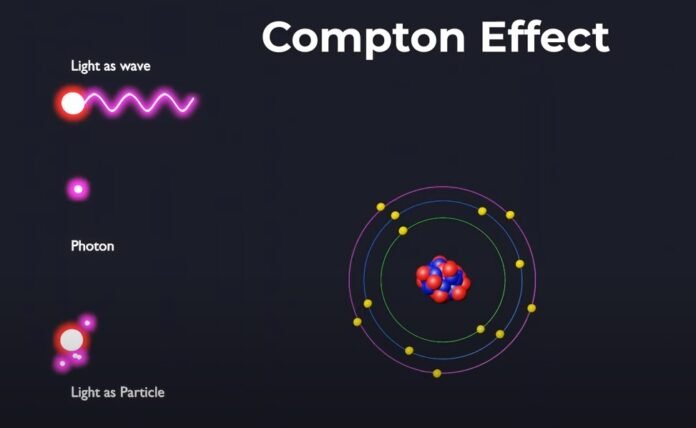The Compton effect (also called the scattering effect) is the change in wavelength or the change in frequency that takes place when electromagnetic radiation essentially collides with a stationary electron. There is a transfer of energy that takes place when this collision occurs. This phenomenon was discovered by Arthur H Compton in 1923. The findings of this experiment further strengthened the quantum theory. In this article, we will learn about Compton’s experiment and we will also derive a mathematical expression of the Compton effect.
Introduction:
The photoelectric effect experiment was the experiment that basically confirmed the quantum theory of light proposed by Albert Einstein. Basically, it confirmed the fact that light consists of individual discrete photons that carry a quantity of energy that depends on the frequency oscillation of the light. Now another experiment that confirmed the quantum theory known as the Compton Effect that conducted by Arthur H Compton in 1923.
Compton effect Experiment:
In this experiment, Arthur H Crompton directed high-energy electromagnetic waves with short wavelengths known as X-rays at stationary electrons. When he examined the collision between those waves and the electrons, he found that the incident electromagnetic wave had a slightly shorter wavelength than that of the waves produced after the collision. So to understand what it means let us consider the illustration of the collision taking place between the photon and electron as shown in the figure below.
![]()
Here the incoming incident wave is a high-energy short wavelength X-ray with a wavelength given by (λ). And there is a stationary electron placed in its path. When this incident sinusoidal wave collides with the electron, some of the energy of the wave is absorbed by the electron and the electron moves away at an angle with respect to the horizontal axis. And the rest of the X-rays are essentially scattered at an angle with respect to the horizontal axis. In this experiment, Arthur H Compton found that the wavelength of scattered X-ray was slightly larger than the wavelength of the incident X-ray. Hence this effect is known as the Compton effect.
Derivation of Compton Effect:
Using the law of conservation of momentum and the law of conservation of energy, Compton derived the following equation which gives the wavelength of scattered X-rays.
λ1 = λ+ (1-cos)———————–1
Where h- Planks constant
me– a mass of electron
C- speed of light
In this equation the term is a constant and it is known as the Compton wavelength of an electron and this value comes about 0.0024nm. So the equation changes only due to the cos term.
And we know that, -1 cos1. Therefore, 0(1-cos)2.
So we can observe that
as the angle changes the term (1-cos) changes from 0 to 2.
The wavelength of scattered X-rays is always greater than the wavelength of the incident waves.
The Compton Shift:
By using equation (1), we can determine the Shift in the wavelength of the incident wave. Which is obtained as
= (1-cos)————————–2
This shift is known as the Compton shift. This represents the shift in the wavelength of the electromagnetic wave that takes place when it collides with the electron.
What wave theory predicts
The wave theory predicts that no wavelength change should take place. The incident electromagnetic wave should cause the electron to oscillate at the same frequency as that of the wave. Therefore the oscillating electron should emit the same EM wave with the same frequency. That implies that there is no shift in the frequency and wavelength of the electromagnetic wave.
Confirmation of Quantum theory
The result of the Compton effect confirmed the quantum theory of light which is that light consists of photons. So basically the incoming photons collide with the stationary electron. And this collision transfers some of the energy within photons to that electron. So the electron gains kinetic energy and begins to move with some velocity. Hence the scattered photon now has less energy than before (E = h f). So this causes a decrease in frequency and an increase in wavelength. And that is exactly what happens in Compton’s experiment.
Applications of Compton Effect:
- Compton scattering is of prime significance in the field of radiobiology. It is the most probable interaction between gamma rays and high-energy X-rays with atoms in living beings. Hence it is applied in radiation therapy to treat cancer.
- Compton scattering is an important effect in gamma spectroscopy as it is possible for gamma rays to scatter out of the detectors used.
- Compton suppression is used to detect stray scattered gamma rays to counteract its effect.
Recommended Articles:
Derivation Of Amplitude Modulation: Introduction, Index, Types, Advantage, And Disadvantage
Derivation of Beer Lambert Law: Statement, Statement, Derivation
Derivation of Bending Equations: Assumptions, Applications, And Frequently
Derivation Of Biot Savart Law: Application, Importance, FAQ
Centripetal Acceleration: Introduction, Force, Derivation, And Applications
